Influence of Coal-Fired Fly Ash on Measurement Error of NO2 Electrochemical Sensors
Abstract
1. Introduction
2. Materials and Methods
2.1. Experimental Materials
2.1.1. Experimental Equipment
2.1.2. NO2 Electrochemical Gas Sensor
2.1.3. Coal-Fired Fly Ash Samples
2.1.4. Experimental Gases
2.2. Experimental Methods
2.2.1. Drying of Coal-Fired Fly Ash Samples
2.2.2. Experimental Tests of Measurement Error of NO2 Electrochemical Gas Sensors
3. Results
3.1. Morphological Characteristics, Elemental Composition, and Pellet Diameter Distribution of Coal-Fired Fly Ash
3.1.1. Morphological Characteristics of Coal-Fired Fly Ash
3.1.2. Elemental Composition and Proportion of Coal-Fired Fly Ash
3.1.3. Pellet Diameter Distribution of Coal-Fired Fly Ash
3.2. Derivation of Sedimentation Velocity of Coal-Fired Fly Ash (Appendix A: Interpretation of Formula Symbols)
3.3. Experimental Test Results of Measurement Error of NO2 Electrochemical Sensor
3.4. Impact of Humidity on Measurement Errors of NO2 Electrochemical Gas Sensors
3.5. Impact of Humidity-Coal Fly Ash Deposition on Measurement Errors of NO2 Electrochemical Gas Sensors
4. Discussion
Author Contributions
Funding
Institutional Review Board Statement
Informed Consent Statement
Data Availability Statement
Acknowledgments
Conflicts of Interest
Appendix A
- Formulas (3)–(5)
- 2.
- Formulas (6) and (7)
- 3.
- Formulas (12) and (13)
References
- The National Energy Administration Released Statistical Data on the National Power Industry from January to September 2023. Available online: http://www.nea.gov.cn (accessed on 8 November 2023).
- Yong, Z.; Dong, M.; Tao, W.; Jia, W.; Yong, G.; Zai, Z.; Carlos, E.; Romero; Wei, P. In-Situ Capture of Mercury in Coal-Fired Power Plants Using High Surface Energy Fly Ash. Environ. Sci. Technol. 2019, 53, 7913–7920. [Google Scholar]
- Gao, C. Study on air pollutant emission estimation of coal boiler in thermal power plant. Environ. Sci. Manag. 2022, 47, 32–37. [Google Scholar]
- Huang, L.; Hu, J.; Chen, M.; Zhang, H. Impacts of power generation on air quality in China-Part I: An overview. Resour Conserv. Recycl. 2017, 121, 103–114. [Google Scholar] [CrossRef]
- Liu, Y.; Yan, J.; Xu, W. Emission characteristics of conventional air pollutants in coal-fired power plants after ultra-low emission transformation. Acta Sci. Circumstantiae 2020, 40, 1967–1975. [Google Scholar]
- Yun, H.; Xie, Y.; Zhang, X. Research on the Adsorption and Transformation of Nitrogen Oxide and Sulphur Dioxide Gases in Thermal Power Plants. Chem. Adhes. 2023, 45, 263–265. [Google Scholar]
- Li, G. The Harm of Nitrogen Oxides to the Environment and Pollution Control Techniques. Shanxi Chem. Ind. 2019, 5, 123–125. [Google Scholar]
- Liang, J.; Zheng, J.; Han, M. Hazards of nitrogen oxides and their treatment technologies. Technol. Innov. Appl. 2021, 24, 120–123. [Google Scholar]
- Wang, Y.; Zhang, L.; Chen, J.; Wen, X. The Harm and Treatment of Nitrogen Oxides in the Atmosphere. Technol. Innov. Appl. 2019, 7, 137–138. [Google Scholar]
- Li, H. Fire Combustion Science; China Machine Press: Beijing, China, 2014; p. 57. [Google Scholar]
- Li, X.; Yong, Y.; Ai, W. Fire and Explosion Protection Engineering; Metallurgical Industry Press: Beijing, China, 2010; p. 75. [Google Scholar]
- GB 13223-2011; Emission Standard of Air Pollutants for Thermal Power Plants. China Environmental Science Press: Beijing, China, 2011; p. 3.
- Zhang, S.; Zhou, L.; Hu, Y.; Liu, X.; Zhang, J. Metal-organic gel derived ZnO/α-Fe2O3 heterostructures for sensitive NO2 detection. Sens. Actuators B. Chem. 2023, 396, 134524. [Google Scholar] [CrossRef]
- Guo, Y.; Jiang, C.; Zheng, X. Research Progress of Mesoporous Metal Oxide Semiconductor NOx Gas Sensors. J. Funct. Mater. Devices 2023, 29, 141–153. [Google Scholar]
- Umesh, Y.; Ravindra, S.; Shaligram, A.D.; Gangal, S.A. Design, simulation, fabrication and testing of Electrochemical NO2 gas sensor. In Proceedings of the 2015 2nd International Symposium on Physics and Technology of Sensors, Pune, India, 7–10 March 2015; pp. 268–272. [Google Scholar]
- Lu, J.; Ling, L.; Dong, K.; Huang, Y.; Hu, R.; Li, A.; Xie, P. Monitoring of atmospheric NO2 and O3 based on electrochemical sensor. Acta Sci. Circumstantiae 2021, 41, 2633–2639. [Google Scholar]
- Qin, H.; Wang, Y.; Yang, Y.; Liu, Z.; Tong, Y.; Xu, H. Design and test of electrochemical NO2 gas sensor based on HTCC technology. J. Light Ind. 2019, 34, 59–63. [Google Scholar]
- HJ 479-2009; Ambient Air—Determination of Nitrogen Oxides—N-(1-Naphthyl)ethylene Diamine Dihydrochloride Spectrophotometric Method. China Environmental Science Press: Beijing, China, 2009; pp. 1–5.
- Wu, Z. Electrochemical Gas Sensor with Gelled Electrolyte. Master’s Thesis, Zhengzhou University, Zhengzhou, China, 2020. [Google Scholar]
- Huang, Y.; Lv, S.; Zheng, X. Progress of NASCION-based electrochemical sensors. J. Funct. Mater. Devices 2023, 29, 164–177. [Google Scholar]
- Md Ashfaque, H.K.; Mulpuri, V.R.; Li, Q. Recent Advances in Electrochemical sensors for Detecting Toxic Gases: NO2, SO2 and H2S. Sensors 2019, 19, 905. [Google Scholar]
- Wan, H.; Yin, H.; Lin, L.; Zeng, X.; Andrew, J.M. Miniaturized planar room temperature ionic liquid electrochemical gas sensor for rapid multiple gas pollutants monitoring. Sens. Actuators B Chem. 2018, 255, 638–646. [Google Scholar] [CrossRef] [PubMed]
- Gorbova, E.; Tzorbatzoglou, F.; Molochas, C.; Chloros, D.; Demin, A.; Tsiakaras, P. Fundamentals and Principles of Solid-State Electrochemical sensors for High Temperature Gas Detection. Catalysts 2022, 12, 1. [Google Scholar] [CrossRef]
- Anirban, P.; Sriram, M.; Shalini, P. Review—Room-Temperature Ionic Liquids for Electrochemical Application with Special Focus on Gas Sensors. J. Electrochem. Soc. 2020, 167, 37511. [Google Scholar]
- Park, C.O.; Fergus, J.W.; Miura, N.; Park, J.; Choi, A. Solid-state electrochemical sensors. Ionics 2009, 15, 261–284. [Google Scholar] [CrossRef]
- Korotcenkov, G. Sensors Technology Series Chemical Sensors, Comprehensive Sensors Technologies, Volume 5: Elcetrochemical and Optical Sensors; Momentum Press: New York, NY, USA, 2013; p. 73. [Google Scholar]
- Alphasense_NO2-B43F_datasheet. Available online: https://www.alphasense.com/products?keyword=NO2-B43F (accessed on 17 December 2023).
- Editorial Board of “Air and Waste Gas Monitoring and Analysis Methods”. Air and Waste Gas Monitoring and Analysis Methods, 4th ed.; China Environmental Science Press: Beijing, China, 2019; p. 128. [Google Scholar]
- HJ 693-2014; Stationary Source Emission—Determination of Nitrogen Oxides—Fixed Potential by Electrolysis Method. China Environmental Science Press: Beijing, China, 2014; p. 1.
- GB 13269-91; Atmospheric Air—Test Dust Standard Sample-Fly Ash. China Environmental Science Press: Beijing, China, 1992; pp. 1–3.
- Qiang, N.; Ji, X.; Xu, B. Air Pollution Control Engineering; Chemical Industry Press: Beijing, China, 2015; pp. 35–40. [Google Scholar]
- Zhao, B. Air Pollution Control Engineering; Chemical Industry Press: Beijing, China, 2017; pp. 31–32. [Google Scholar]
- GB/T 21354-2008/ISO 3935:1993; Power-Determination of Tap Density (ISO 3953:1993, Metallic Powers-Determination of tap density, IDT). China Environmental Science Press: Beijing, China, 2008; pp. 1–3.
- Lei, J.; Wu, X.; Wu, J. Aerodynamics; Beijing University of Technology Press: Beijing, China, 2015; p. 348. [Google Scholar]
- Cai, J. Air Filtration ABC; China Construction Industry Press: Beijing, China, 2002; p. 2. [Google Scholar]
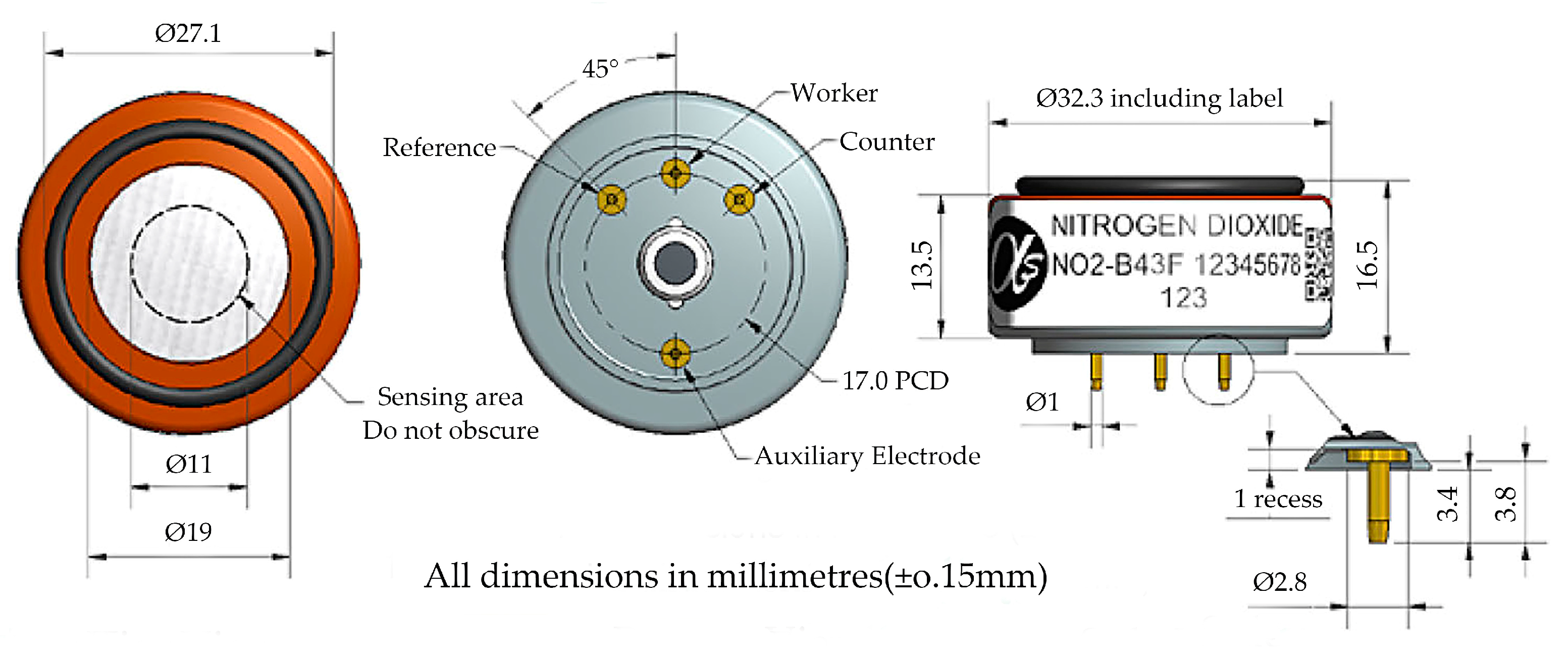

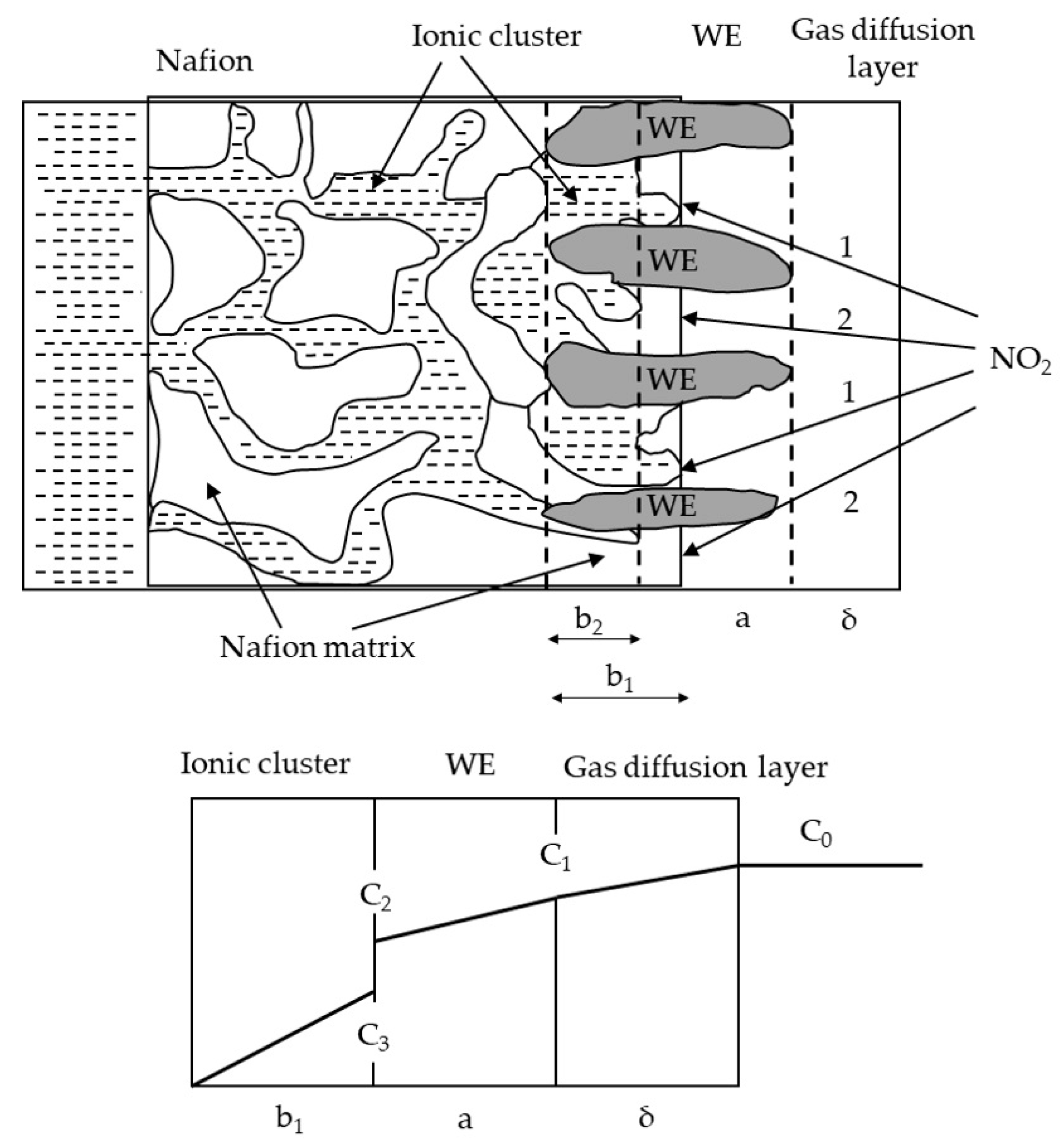


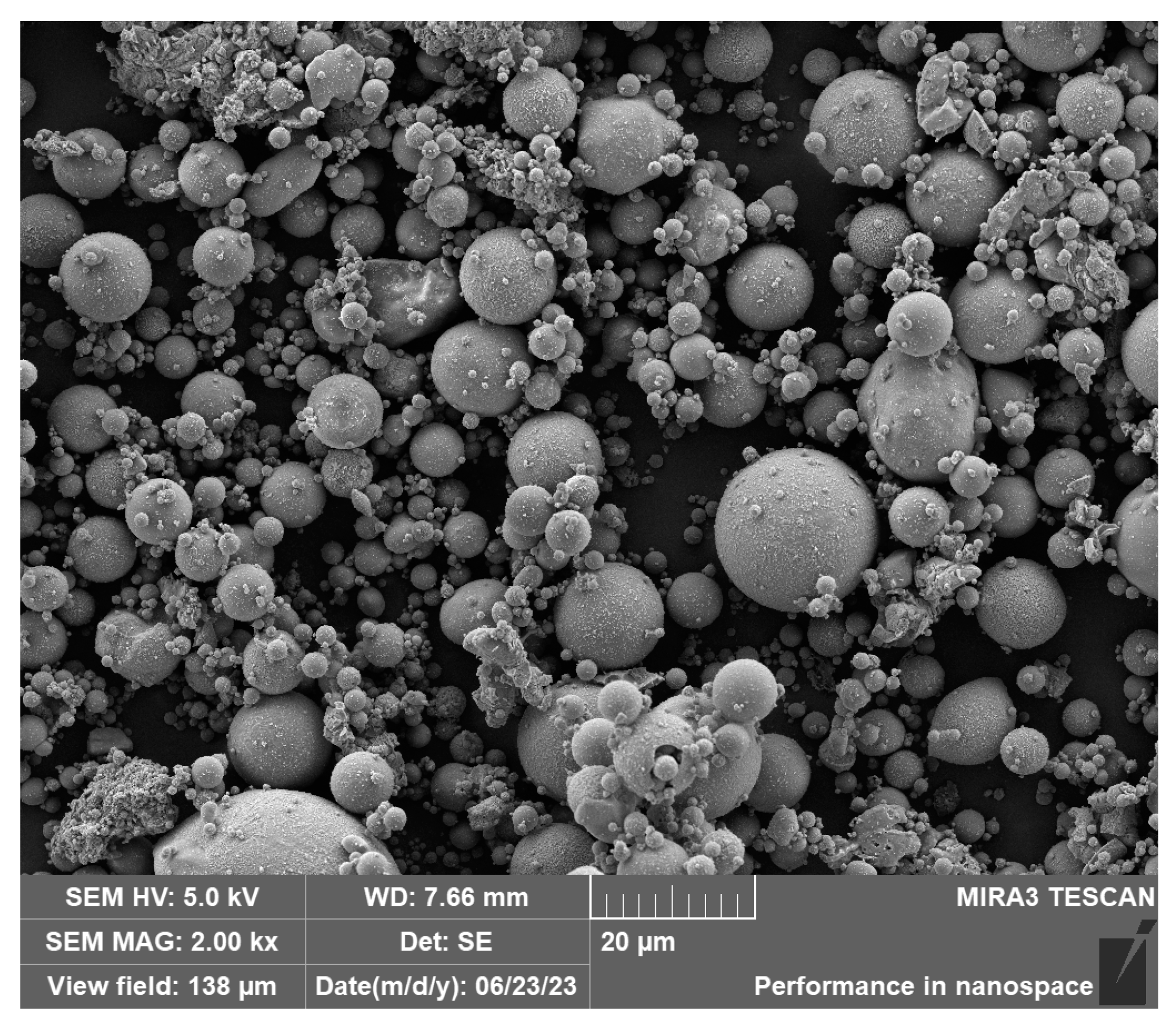
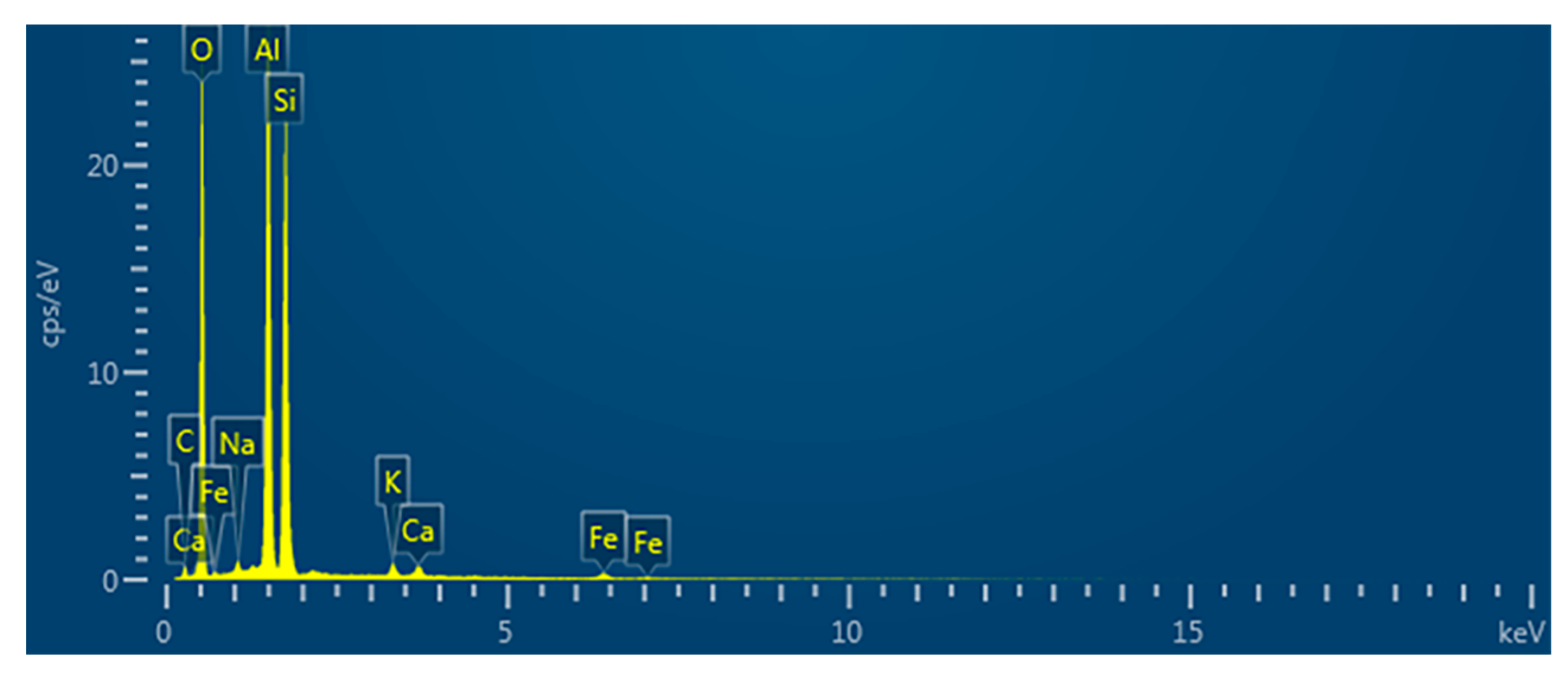
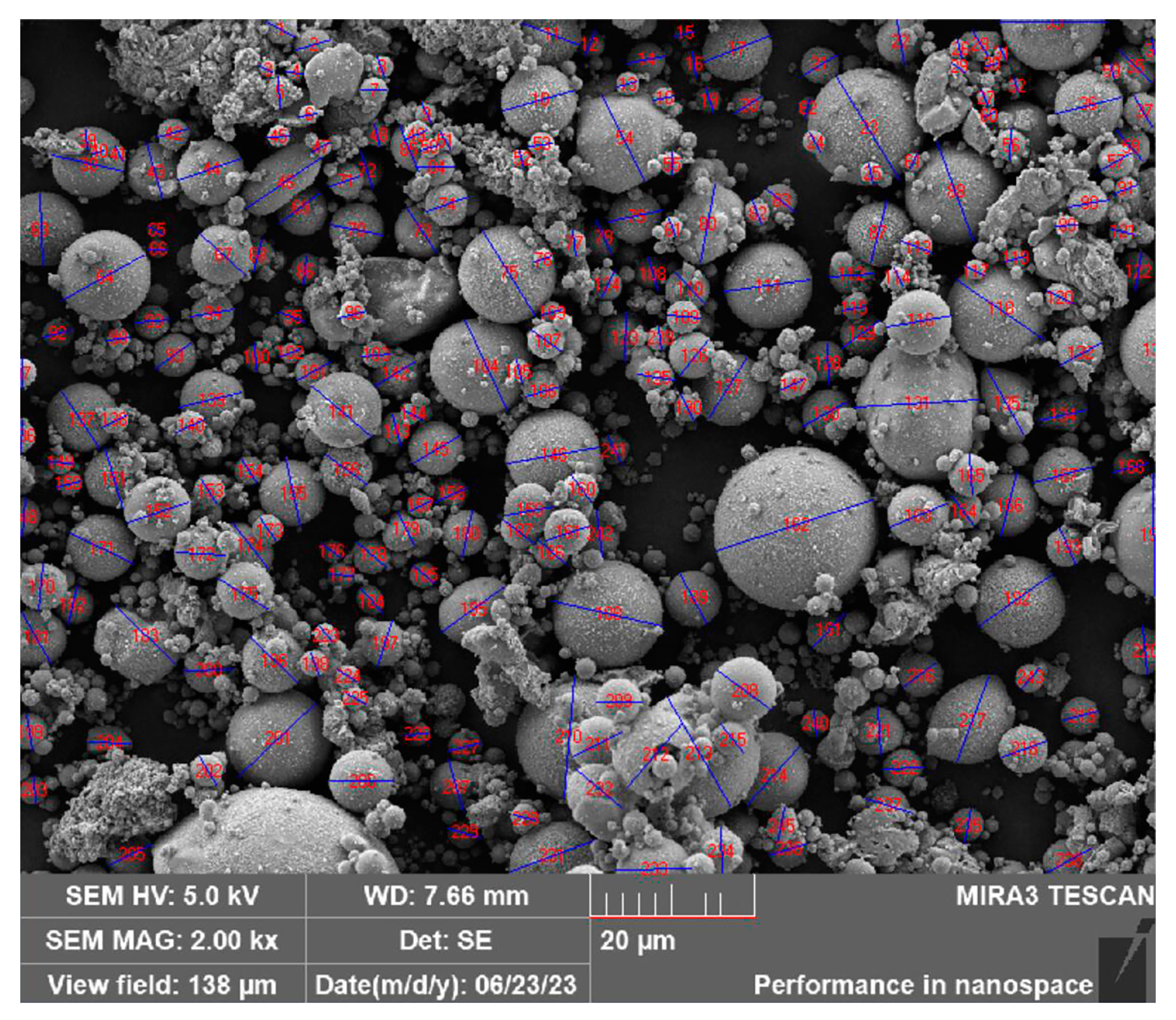


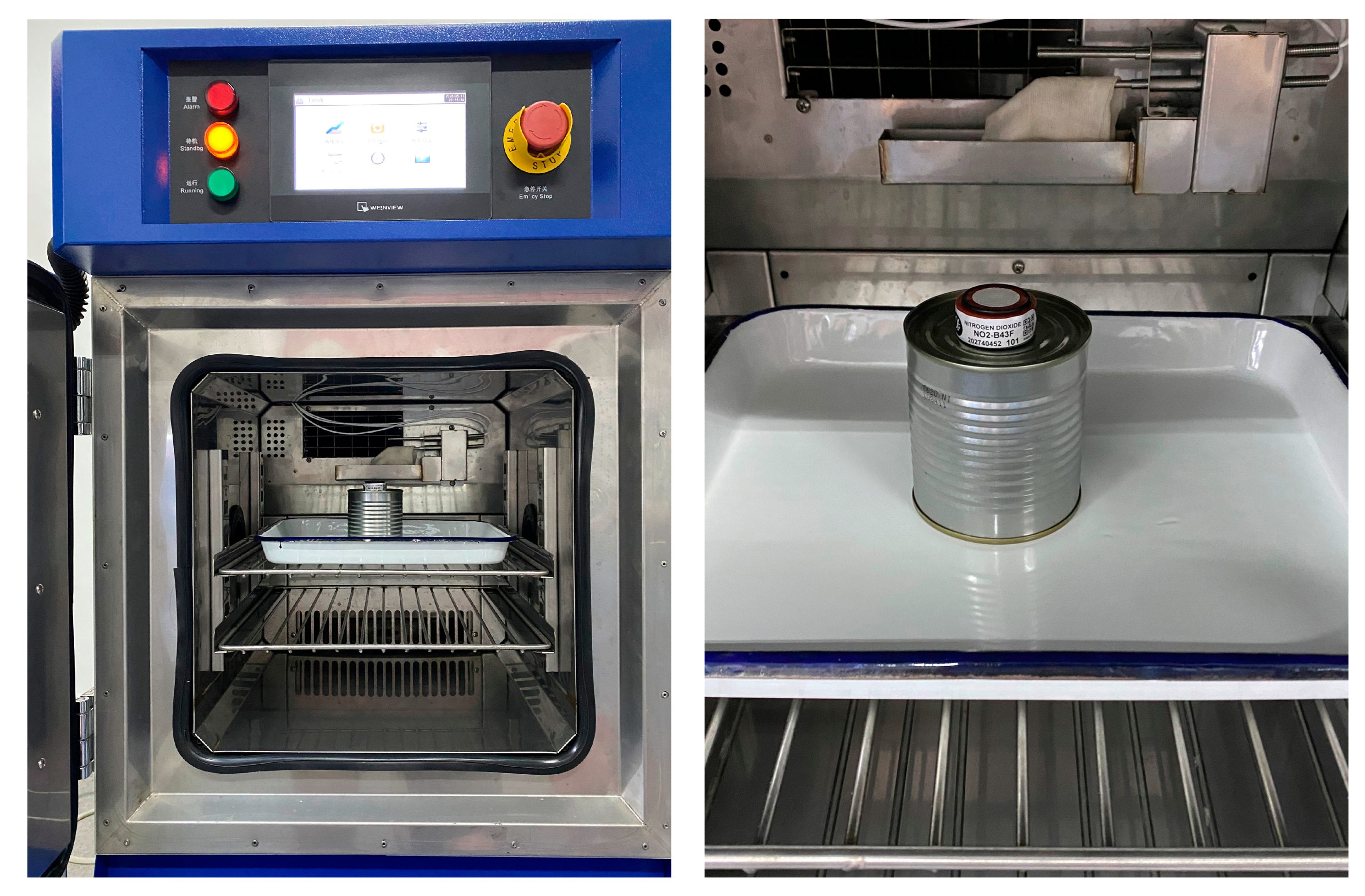
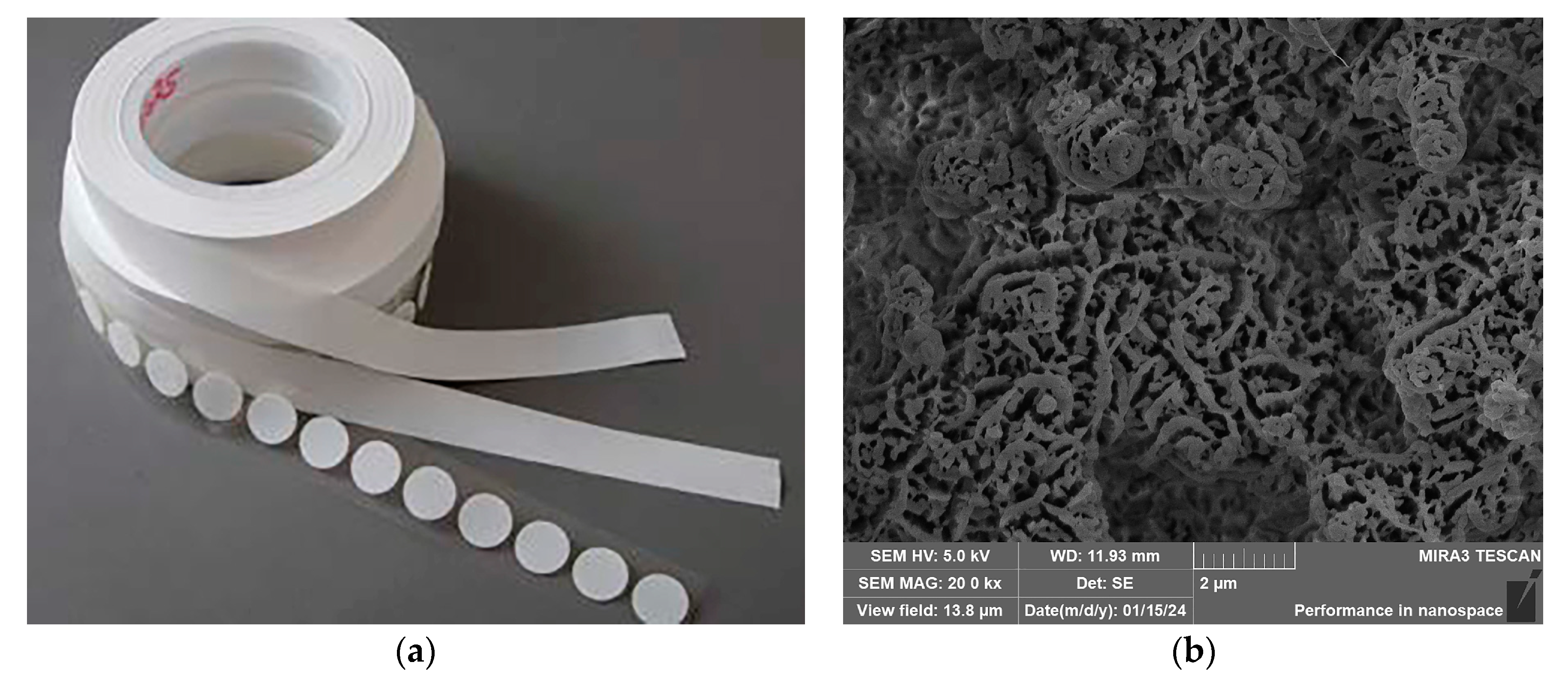
| Category | Indicator | Description | Value |
|---|---|---|---|
| Specifications | Sensitivity | nA/ppm at 2 ppm NO2 | −200 to −650 |
| Response time | t90(S) from 0 to 2 ppm NO2 | <80 | |
| Zero current | nA in zero air at 20 °C | −80 to +80 | |
| Noise | ±2 standard deviations (ppb equivalent) | 15 | |
| Range | ppm NO2 limit of performance warranty | 20 | |
| Linearity | ppb error at full scale, linear at zero and 20 ppm | <±0.5 | |
| Overgas limit | NO2 maximum ppm for stable response to gas pulse | 50 | |
| Lifetime | Zero drift | ppb equivalent change/year in lab air | 0 to 20 |
| Sensitivity drift | % change/year in lab air, monthly test | −20 to −40 | |
| Operating life | Months until 50% original signal (24-month warranty) | >24 | |
| Environmental | Sensitivity at −20 °C | % (output at −20 °C/output at 20 °C) at 2 ppm NO2 | 60 to 80 |
| Sensitivity at 40 °C | % (output at 50 °C/output at 20 °C) at 2 ppm NO2 | 95 to 115 | |
| Zero at −20 °C | nA | 0 to 25 | |
| Zero at 40 °C | nA | −10 to 50 | |
| Cross-sensitivity | H2S | % measured gas at 5 ppm | <−80 |
| NO | % measured gas at 5 ppm | <5 | |
| Cl2 | % measured gas at 5 ppm | <100 | |
| SO2 | % measured gas at 5 ppm | <−3 | |
| CO | % measured gas at 5 ppm | <−3 | |
| Key specifications | Temperature range | °C | −30 to 40 |
| Pressure range | kPa | 80 to 120 | |
| Humidity range | %rh continuous | 15 to 85 | |
| Storage period | Months at 3 to 20 °C | 6 | |
| Load resistor | Ω (ISB circuit is recommended) | 33 to 100 | |
| Weight | g | <13 |
| O | Si | Al | C | Fe | K | Ca | Na |
|---|---|---|---|---|---|---|---|
| 50.39 | 20.40 | 19.94 | 6.23 | 0.92 | 0.80 | 0.72 | 0.60 |
| Distribution/μm | Average/μm | Quantity | Percentage/% |
|---|---|---|---|
| 1–3 | 2.50 | 51 | 20.99 |
| 3–5 | 3.97 | 87 | 35.80 |
| 5–7 | 5.84 | 47 | 19.34 |
| 7–9 | 7.89 | 26 | 10.70 |
| 9–11 | 9.83 | 13 | 5.35 |
| 11–13 | 12.04 | 12 | 4.94 |
| 13–15 | 14.44 | 4 | 1.65 |
| 15–17 | 15.2 | 2 | 0.82 |
| 17–19 | 0 | 0 | 0.00 |
| 19–21 | 20.07 | 1 | 0.41 |
| Deposition Time | 1 h | 1 Day | 30 Days | 60 Days | 90 Days | 120 Days | 150 Days | 180 Days |
|---|---|---|---|---|---|---|---|---|
| Deposition Quantities/mg | 33.1 × 10−3 | 0.80 | 24 | 48 | 72 | 96 | 120 | 144 |
| Sensor Measurement/ppm | Deposition Duration/Days | |||||||
|---|---|---|---|---|---|---|---|---|
| 0 | 30 | 60 | 90 | 120 | 150 | 180 | ||
| NO2 gas concentration/ppm | 0 | 0 | 0 | 0 | 0 | 0 | 0 | 0 |
| 10 | 9.740 | 6.965 | 5.020 | 3.682 | 3.222 | 2.182 | 1.051 | |
| 20 | 19.551 | 17.141 | 15.409 | 14.727 | 13.227 | 8.500 | 4.985 | |
| 30 | 29.318 | 27.869 | 23.788 | 21.591 | 19.975 | 17.015 | 15.742 | |
| 40 | 39.717 | 36.551 | 34.869 | 32.091 | 29.192 | 27.753 | 25.111 | |
| 50 | 49.568 | 46.409 | 44.232 | 42.586 | 37.894 | 35.646 | 32.641 | |
| 60 | 59.636 | 55.470 | 52.217 | 51.914 | 44.146 | 42.273 | 38.005 | |
| 70 | 69.646 | 64.662 | 59.596 | 60.591 | 53.475 | 50.278 | 45.859 | |
| 80 | 79.207 | 74.460 | 67.131 | 65.202 | 62.753 | 59.889 | 49.449 | |
| 90 | 89.712 | 83.965 | 76.439 | 76.576 | 68.242 | 63.773 | 57.939 | |
| 100 | 99.439 | 91.985 | 87.343 | 83.338 | 79.232 | 75.970 | 69.217 | |
| Sensor Measuring/ppm | Measurement Errors/% | |||||||
|---|---|---|---|---|---|---|---|---|
| 0 | 30 | 60 | 90 | 120 | 150 | 180 | ||
| NO2 gas concentration/ppm | 0 | 0 | 0 | 0 | 0 | 0 | 0 | 0 |
| 10 | 2.600 | 30.350 | 49.800 | 63.180 | 67.780 | 78.180 | 89.490 | |
| 20 | 2.245 | 14.295 | 22.955 | 26.365 | 33.865 | 57.500 | 75.075 | |
| 30 | 2.273 | 7.103 | 20.707 | 28.030 | 33.417 | 43.283 | 47.527 | |
| 40 | 0.708 | 8.623 | 12.828 | 19.773 | 27.020 | 30.618 | 37.223 | |
| 50 | 0.864 | 7.182 | 11.536 | 14.828 | 24.212 | 28.708 | 34.718 | |
| 60 | 0.607 | 7.550 | 12.972 | 13.477 | 26.423 | 29.545 | 36.658 | |
| 70 | 0.506 | 7.626 | 14.863 | 13.441 | 23.607 | 28.174 | 34.487 | |
| 80 | 0.991 | 6.925 | 16.086 | 18.498 | 21.559 | 25.139 | 38.189 | |
| 90 | 0.320 | 6.706 | 15.068 | 14.916 | 24.176 | 29.141 | 35.623 | |
| 100 | 0.561 | 8.015 | 12.657 | 16.662 | 20.768 | 24.030 | 30.783 | |
| Sensor Measurement/ppm | Humidity Level | ||||
|---|---|---|---|---|---|
| 25%RH | 50%RH | 75%RH | 98%RH | ||
| NO2 gas concentration/ppm | 0 | 0 | 0 | 0 | 0 |
| 10 | 9.538 | 9.532 | 9.647 | 9.727 | |
| 20 | 19.251 | 19.407 | 19.725 | 19.891 | |
| 30 | 28.650 | 29.123 | 29.414 | 29.379 | |
| 40 | 38.571 | 38.786 | 39.025 | 39.449 | |
| 50 | 48.946 | 49.099 | 49.197 | 49.446 | |
| 60 | 58.818 | 58.197 | 59.167 | 59.217 | |
| 70 | 68.010 | 68.616 | 69.379 | 69.488 | |
| 80 | 78.227 | 79.069 | 79.118 | 79.808 | |
| 90 | 88.300 | 88.714 | 88.852 | 89.537 | |
| 100 | 98.906 | 98.498 | 99.655 | 99.828 | |
| Sensor Measuring/ppm | 30 Days’ Deposition | 60 Days’ Deposition | |||||||
|---|---|---|---|---|---|---|---|---|---|
| 25% RH | 50% RH | 75% RH | 98% RH | 25% RH | 50% RH | 75% RH | 98% RH | ||
| NO2 gas concentration/ppm | 0 | 0 | 0 | 0 | 0 | 0 | 0 | 0 | 0 |
| 10 | 5.449 | 5.530 | 5.879 | 5.283 | 4.813 | 4.692 | 4.187 | 4.005 | |
| 20 | 16.641 | 15.884 | 14.995 | 14.611 | 15.874 | 15.162 | 15.010 | 14.616 | |
| 30 | 24.828 | 22.742 | 22.177 | 20.712 | 23.192 | 22.268 | 22.232 | 22.010 | |
| 40 | 36.273 | 35.439 | 33.970 | 28.571 | 34.470 | 33.505 | 33.064 | 32.793 | |
| 50 | 46.343 | 43.975 | 41.040 | 37.854 | 43.672 | 41.793 | 40.066 | 39.081 | |
| 60 | 53.485 | 51.389 | 49.601 | 49.551 | 51.899 | 50.465 | 49.141 | 48.626 | |
| 70 | 64.505 | 63.616 | 62.687 | 59.848 | 61.803 | 61.581 | 60.793 | 59.520 | |
| 80 | 72.525 | 71.641 | 71.066 | 67.268 | 66.768 | 65.742 | 65.414 | 64.404 | |
| 90 | 82.510 | 82.217 | 82.131 | 78.727 | 76.455 | 75.192 | 73.212 | 72.990 | |
| 100 | 90.404 | 89.722 | 87.616 | 84.869 | 84.030 | 83.566 | 83.535 | 83.071 | |
Disclaimer/Publisher’s Note: The statements, opinions and data contained in all publications are solely those of the individual author(s) and contributor(s) and not of MDPI and/or the editor(s). MDPI and/or the editor(s) disclaim responsibility for any injury to people or property resulting from any ideas, methods, instructions or products referred to in the content. |
© 2024 by the authors. Licensee MDPI, Basel, Switzerland. This article is an open access article distributed under the terms and conditions of the Creative Commons Attribution (CC BY) license (https://creativecommons.org/licenses/by/4.0/).
Share and Cite
Chen, W.; Zhou, H.; Wu, S.; Liao, D. Influence of Coal-Fired Fly Ash on Measurement Error of NO2 Electrochemical Sensors. Sensors 2024, 24, 900. https://doi.org/10.3390/s24030900
Chen W, Zhou H, Wu S, Liao D. Influence of Coal-Fired Fly Ash on Measurement Error of NO2 Electrochemical Sensors. Sensors. 2024; 24(3):900. https://doi.org/10.3390/s24030900
Chicago/Turabian StyleChen, Wei, Hui Zhou, Shijing Wu, and Dongmei Liao. 2024. "Influence of Coal-Fired Fly Ash on Measurement Error of NO2 Electrochemical Sensors" Sensors 24, no. 3: 900. https://doi.org/10.3390/s24030900
APA StyleChen, W., Zhou, H., Wu, S., & Liao, D. (2024). Influence of Coal-Fired Fly Ash on Measurement Error of NO2 Electrochemical Sensors. Sensors, 24(3), 900. https://doi.org/10.3390/s24030900





